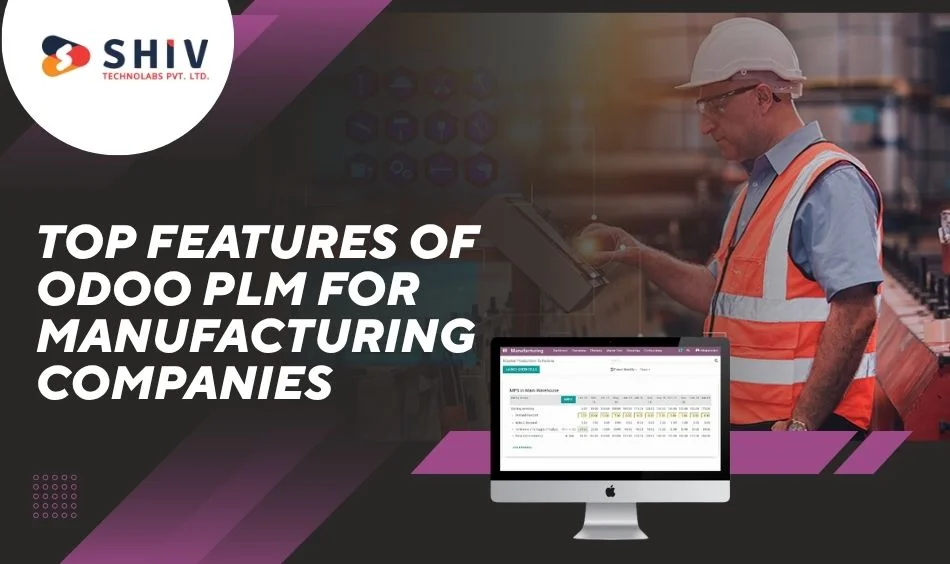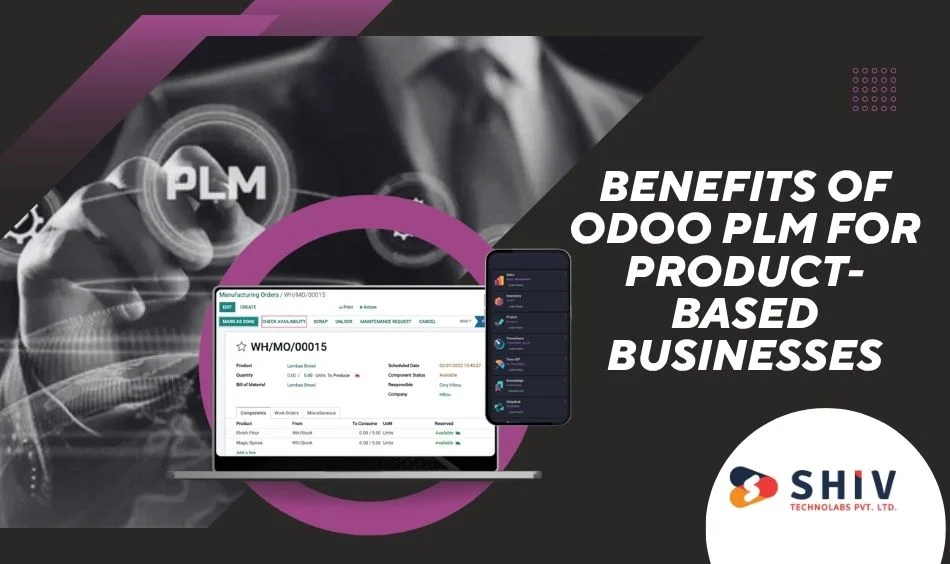Table of Contents
Every product goes through many changes from the idea stage to its final version. These changes include design updates, new parts, quality checks, and other improvements over time. Keeping track of all this can be hard, especially for manufacturing companies that deal with complex products.
That’s where Product Lifecycle Management (PLM) comes in. A PLM system helps teams manage product details, track revisions, and handle approval workflows from one place.
Odoo PLM is one such tool built into the Odoo ERP system. It’s designed for companies that need to track changes in designs, documents, bills of materials (BoMs), and engineering tasks. The best part is—it connects easily with other Odoo apps like Inventory, Manufacturing, and Purchase.
In this blog, we will look at how Odoo PLM works, its top features, and how to use it in a real business process.
What Is Odoo PLM Software?
Odoo PLM (Product Lifecycle Management) is a software module that helps businesses manage the full journey of a product’s development. It covers everything from design changes to document control and product updates.
The module is made for engineering and manufacturing teams. It helps them:
- Track design versions
- Handle engineering change orders (ECOs)
- Store technical documents
- Connect with manufacturing orders
Odoo PLM works closely with Odoo Manufacturing (MRP). So when a change is made to a product design or BoM, it reflects directly in the production process. This helps avoid confusion, saves time, and reduces errors.
Odoo PLM also supports PDF files, images, CAD drawings, and other document types. These files can be linked directly to a product or BoM.
Top Features of Odoo PLM for Manufacturing Companies

Let’s break down the most useful features of Odoo PLM:
# Engineering Change Orders in Odoo PLM
Engineering Change Orders (ECOs) are used to make updates to a product. It could be a change in design, a part replacement, or a change in process.
In Odoo PLM, you can:
- Create ECOs for single or multiple products
- Choose the type of change (new BoM, new routing, etc.)
- Add approval steps before applying the changes
Each ECO has a clear path from creation to approval, helping teams know exactly what has changed and why.
# Managing Technical Documents in Odoo PLM
Technical documents are a big part of product design. These can be files like:
- Assembly instructions
- Design drawings (PDF, PNG, or CAD files)
- Technical specs and part sheets
Odoo PLM allows you to attach these files directly to BoMs and products. You can also store different versions of the same file. That way, engineers and managers can always find the latest version.
# Product BoM Version Control in Odoo PLM
If you make physical products, your team likely uses a Bill of Materials (BoM). Odoo PLM supports BoM versioning, which means:
- You can create multiple versions of a BoM
- Compare the changes between versions
- Keep records of which version was used and when
This is useful when the product goes through frequent updates. For example, if a part is replaced or removed, the team can see which version of the BoM it affected.
# Collaboration Features in Odoo PLM Module
Odoo PLM includes a “Chatter” feature on each record. It helps team members:
- Add comments on product changes
- Mention coworkers who need to act
- Track approval and rejection notes
This keeps communication inside the system, rather than scattered across emails or chats.
# Real-Time Product Updates in Odoo PLM and Odoo MRP
One big benefit of Odoo PLM is that it works with Odoo’s Manufacturing app (MRP). So, when a change is made in PLM—like a new part in a BoM—it automatically shows up in MRP. This removes the need to manually update production data.
How to Use Odoo PLM – Step-by-Step Workflow
Here’s how a typical team would use Odoo PLM in their product development process:
# Step 1: Set Up Products and BoMs
Start by creating the product in Odoo. Add a Bill of Materials (BoM) to define what parts are used to build the product. You can attach files like design drawings or manuals to the BoM.
# Step 2: Upload and Link Design Documents
Upload design files or product manuals and attach them to the product or BoM. You can use PDFs, images, or CAD files. Make sure to name each file version.
# Step 3: Create and Track ECOs in Odoo
If there’s a change in the design, create an Engineering Change Order (ECO). Choose the type of change, like “new BoM” or “routing update.” Assign it to the right team members for review.
# Step 4: Assign Reviewers and Approve Changes
Once the ECO is ready, it can go through an approval process. You can assign specific reviewers and track their decisions. Notes, comments, and approvals are stored in the ECO thread.
# Step 5: Apply Updates to Manufacturing Process
After approval, the changes from the ECO are applied. The updated BoM or routing is now active in the system. This update is visible in the Manufacturing module, so production follows the new plan.
Benefits of Odoo PLM for Product-Based Businesses

Odoo PLM is more than just a tool for engineers. It helps different departments work together while reducing mistakes and saving time. Let’s look at some of the key advantages:
# Better Control Over Product Changes
With Engineering Change Orders (ECOs), every product update is tracked. You know when something changed, who made the change, and why it was needed. This prevents confusion and makes it easier to fix issues later.
# Document Management Made Simple
Odoo PLM makes it easy to keep all design files, technical drawings, and part details in one place. Anyone in the team can access the latest version of a file from the product page or the BoM.
# Faster Approval Process
You can create approval rules based on your company’s process. For example, a design change might need approval from the head of engineering and quality control. Odoo PLM helps route the ECO through the right steps.
# Reduced Errors in Production
Because the system updates product and manufacturing details together, the production team always works with the latest data. This helps reduce costly mistakes on the shop floor.
# Easy Communication Across Teams
Odoo PLM includes built-in tools for messaging. Engineers, managers, and production leads can add notes and tag each other inside the system. This makes collaboration easier, especially in remote teams.
# Built-in Connection with Manufacturing
Any change approved in the PLM module is passed directly to Odoo MRP. You don’t have to update BoMs or routing steps in two places. This connection keeps everything in sync.
Read more: Odoo vs SAP
Odoo PLM vs Other PLM Software
Let’s compare Odoo PLM with traditional PLM tools used in the manufacturing industry.
| Feature | Odoo PLM | Traditional PLM Tools |
|---|---|---|
| Cost | More budget-friendly | Often expensive |
| Integration with ERP | Built into Odoo ERP | Usually requires extra work |
| User Interface | Clean and simple | Can be complex |
| Document Management | Supports attachments & versions | Usually file-based |
| Ideal For | Small to mid-sized companies | Medium to large enterprises |
| Real-time Updates to MRP | Yes | Sometimes missing |
Odoo PLM is a great choice for businesses that want all the features in one system without spending too much. Since it’s part of the Odoo platform, it works smoothly with other modules like Inventory, Purchase, and Quality.
Industries That Benefit from Odoo PLM Solutions
Many industries can use Odoo PLM to handle product changes and document tracking. Some examples include:
# Electronics
Companies making electronic goods often deal with rapid changes in design, components, and assembly steps. Odoo PLM helps manage these updates while reducing time spent on manual checks.
# Automotive
The auto industry requires precise part management, version control, and proper approvals. Odoo PLM fits well with this need and connects directly to manufacturing workflows.
# Consumer Goods
When packaging or product designs change often, it’s important to keep track of different versions. Odoo PLM allows teams to manage documents and send changes to production without delay.
# Furniture and Fixtures
Businesses that build made-to-order furniture or fixtures can use Odoo PLM to track design revisions, attach technical specs, and manage material changes.
# Machinery and Equipment
For companies that manufacture large machines or equipment, Odoo PLM supports control over parts, drawings, BoMs, and version records.
For more info: Industry-Specific ERP Solutions
Why Choose Shiv Technolabs for Odoo PLM Implementation
Setting up Odoo PLM the right way can make a big difference. Shiv Technolabs helps companies get the most out of Odoo by offering the following services:
- Setup and Configuration
- Custom Module Adjustments
- Team Training
- Ongoing Support
With experience in manufacturing and ERP software, our team makes sure your PLM setup works smoothly and adds real value to your daily work.
To Sum Up
Odoo PLM helps companies take better care of product updates, technical documents, and design approvals. It connects engineers, managers, and factory teams so everyone stays on the same page.
By keeping product data in one place and linking changes directly to manufacturing, Odoo PLM saves time and cuts down on confusion. For businesses that build physical products, this tool can make daily tasks easier and reduce costly mistakes.
If you’re looking for a better way to manage your product lifecycle, Odoo PLM is a smart choice. And with the right setup from Shiv Technolabs, you’ll get a solution that fits your business from day one.






















